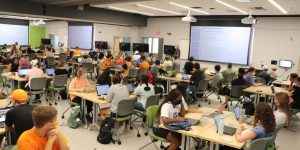
Engineering Vols love it when a plan comes together.
TCE’s Engineering Fundamentals (EF) team created a wishlist for the design of classrooms in the Zeanah Engineering Complex. They shared the ways they wanted these spaces to work with building planners, and their input was utilized extensively.
The over-arching idea was for the spaces to welcome students into the world of engineering and to begin that experience from their first moments in class. They wanted to encourage group work that immediately engages students in collaboration.
“We didn’t want the traditional lecture hall, where students are just sitting and listening,” said Richard Bennett. “We wanted them actively involved in the learning.”
They now have the classrooms they imagined, and the approach has worked wonders in practice.
EF faculty looked at the ways other institutions applied their engineering pedagogy and how they used their teaching spaces. They tried out various aspects of this through use of large auditoriums in Strong Hall and the Mossman building. They saw the need for the space to allow students to learn from each other, as well as instructors.
“So that led to ‘no-front-of-the-classroom.’ That led to tables where students are working in teams of four to six, roughly,” said Bennett. “It’s very interesting in the classroom now—there’ll be some that work in two or three and then you get these groups that are moving chairs from the other table and they have eight there. And it’s all good.”
The flexibility of the space has helped the EF team hit a new stride—evident from their very first day in the ZEC classrooms.
“I teach three classes back to back, so with the 25 minutes between classes, you know, that’s about four hours that I’m in there,” said Bennett.
It was both taxing and exhilarating for him, especially following the pandemic year of classes via Zoom.
“I was physically exhausted but I was, emotionally, on a super high,” he said. “We just said, ‘Wow, this is working like we wanted it to.’ I’m in my 39th year of teaching and I’m having the most fun I’ve ever had—to see the energy of the students teaching each other, working together.”
The very size of these spaces is flexible, as well, offering the ability to host a full room 128 students collaborating in groups or—with the deployment of a few walls—offering more intimate spaces in which students can interact more closely with instructors during lab sessions.
Bennett points out the combination of elements that make it all work, from the flexibility of the rooms to the flexibility of the furniture. All of the tables and seating in the classrooms can be moved and arranged however it best serves the day’s purposes.
It’s also important that the groups of student working together at any given table can communication with other groups or the instructors via interactive multiple screens throughout the room.
“We’re sort of pushing the envelope here in a sense,” said Bennett. “The ability for me to not be tied to an HDMI cable, to be able to walk around—that’s really helpful. Students can use the monitor to write together, get on the internet, or a variety of things. We’re still, admittedly, figuring out the best way, all the capabilities and stuff, but it has really worked out well.”
It all comes together to produce the original desired effect: that students are learning in an active, collaborative way—and even teaching each other.
“I tell the students all the time that the best way to learn something is to teach it,” said Bennett. “If you’re helping somebody that’s struggling, that’s really helping you, too.”
In that way, the Volunteer Spirit echoes throughout the Zeanah Engineering Complex.
See the full article on the UTK TCE Website.